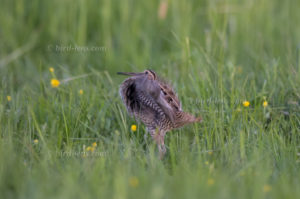 A creaky staccato. A Great Snipe (Gallinago media) shakes itself in extacy. Then the snipe jumps briefly in the air. This can last for many hours at the midnight mating court, a lek. Common Snipes (Gallinago gallinago) also perform their courtship with sounds. But these are very different from those of the Great Snipe.
A creaky staccato. A Great Snipe (Gallinago media) shakes itself in extacy. Then the snipe jumps briefly in the air. This can last for many hours at the midnight mating court, a lek. Common Snipes (Gallinago gallinago) also perform their courtship with sounds. But these are very different from those of the Great Snipe.
Loud, panicked calls are likely to serve several purposes. Perhaps they should warn other members of their own species nearby. Or scare the predator into an extra millisecond to escape. Once in the air, snipes fly like bats out of hell in an irregular, spinning zigzag flight. This flight maneuver makes tracking difficult – whether for hunters or bird photographers.
The Great Snipe is of the cozier kind, although it is also capable of a quick escape flight. The challenge in Great Snipe photography is the combination of a cryptic and mysterious bird that lives in inaccessible wetlands, has a remarkable diurnal rhythm, and an exciting courtship. That makes the snipe a highly thought-after photo motif.
So I set out to photograph the Great Snipe in sparsely populated Estonia in one of the wide river valleys with extensive grass meadows.
As cold as the winters, as dry and hot as the summers can be in Estonia. As early as May, the temperature climbs to over 30 degrees on the Kasari lowlands and you can quickly get sunburned. In view of the ongoing climate change, the Estonian marshland appears like a green lung for the whole country, if not all of Europe. My fear is that with EU funds the small-scale Estonian agriculture will disappear as well as the currently countless swamp meadows, streams and river meanders and fallow forests. Photographically there are certainly simpler landscapes than the lowlands in western Estonia. There are only a few accessible and public roads. Often you reach your limits, you are not allowed to go any further and you could not even if you were allowed to. As a observator from one of the observation towers you can enjoy the sight and call of the Great Snipe in the sedge reed, but you also know that where the snipe is courting, no tent can be built because the water level in front of it is too high. In numerous other swamp meadows, where access would be theoretically and practically possible, one struggles with the pitfalls of the terrain and then realizes quite clearly how comparatively easy photography is in our land-cleared landscape.
In Germany there are many, partly asphalted paths, the remaining animals have had to adapt to the people and have also reduced their escape distance a little, so that the crowd of photographers in vehicles is correspondingly large at the few hotspots of Central European nature photography.
When, in the further course of the Kasari lowland, I discovered a swamp meadow with water gullies, to which Whiskered Terns (Chlidonias hybrida), White-winged Terns (Chlidonias leucopterus) and Black Terns (Chlidonias niger) flew in en masse, the approach and the setting up of the tent was the biggest problem. Up to the stomach in the water, the legs bloodily scratched by the blades of crab claws and bitten by hundreds of mosquitoes. That was just the price for reaching a suitable place to photograph from the tented hide the terns, which gracefully fluttered over the surface of the water to pick insects.
In order to meet the growing demand for top images of the rarer species of Palaearctic Bird-lens.com has specifically made trips to remote places. Additionally every chance is used, if a rare bird is around the homeground. This to do everything to ensure excellent photos of the Birds of the Western Palearctic . The yield of pictures also of rare Western Palaearctic birds is very good. There are other nice images of birds, that you will find behind the tab “Picture Shop“. Just give a notice if you need a picture of a bird which is not online
Tag: